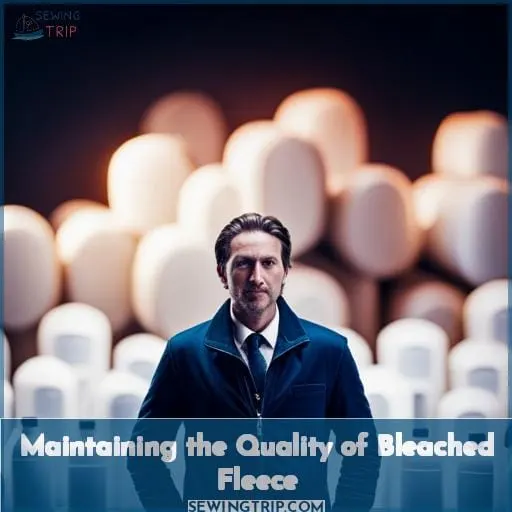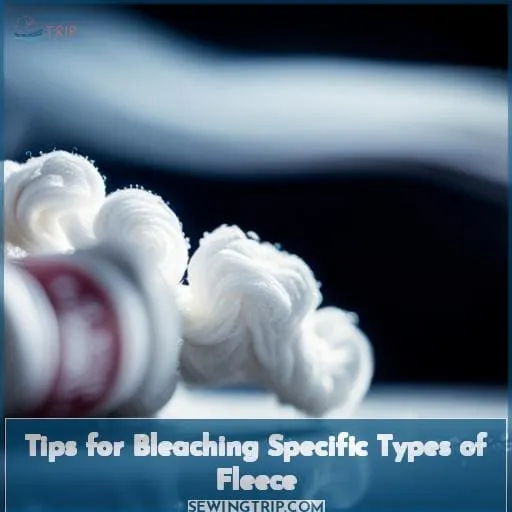This site is supported by our readers. We may earn a commission, at no cost to you, if you purchase through links.
 Looking to brighten up your fleece? Wondering if you can safely bleach it without causing damage? Look no further! In this article, we will guide you through the process of safely bleaching fleece. From preparing the fabric to proper bleaching techniques and care instructions, we’ve got you covered.
Looking to brighten up your fleece? Wondering if you can safely bleach it without causing damage? Look no further! In this article, we will guide you through the process of safely bleaching fleece. From preparing the fabric to proper bleaching techniques and care instructions, we’ve got you covered.
Let’s dive in and learn how to safely whiten your beloved fleece.
Table Of Contents
Key Takeaways
- Bleach can be used on fleece for stain removal and odor control.
- It is important to follow safe bleaching practices and test a small area before full bleaching.
- Alternatives to bleach, such as vinegar or oxygen-based agents, can be used for whitening and deodorizing fleece.
- Proper post-bleaching care is crucial for maintaining the quality and longevity of fleece.
Can You Bleach Fleece?
When it comes to bleaching fleece, it’s important to consider its effectiveness.
Bleach can be used on fleece to remove water repellent properties and control odors, but the colors of the fabric are generally not affected when bleach is used in small amounts.
However, unscented products like bleach are recommended to prevent odor buildup.
The Effectiveness of Bleaching on Fleece
Bleaching fleece can be an effective method to whiten and remove stains from the fabric. It’s important to ensure safe bleaching practices for maintaining the quality of fleece.
Here are some key points to consider:
- Bleach effectiveness in whitening and stain removal
- Safe bleaching techniques for fleece maintenance
- Alternative methods to bleach, such as vinegar or oxygen-based agents
- Proper care instructions after bleaching
- Tips for removing stains from fleece without using bleach
Potential Risks and Considerations
Before considering bleaching fleece, it’s important to understand the potential risks and considerations involved.
Bleaching can affect the color and quality of fleece, potentially leading to discoloration or damage. It’s crucial to follow safe techniques and use appropriate dosages of bleach or alternative methods like vinegar for stain removal.
Additionally, proper care practices should be implemented post-bleaching to maintain the overall quality of the fleece fabric.
How to Safely Bleach Fleece
To safely bleach fleece, it’s important to first prepare the fabric by checking for any specific care instructions.
Follow proper bleaching techniques and dosage, using a suitable amount of bleach to avoid excessive odor.
After bleaching, rinse the fleece thoroughly and follow appropriate care instructions to maintain its quality and performance.
Preparing the Fleece for Bleaching
To safely bleach fleece, you’ll need to prepare the fabric beforehand by following a few simple steps:
- Check the care label for any specific instructions or warnings.
- Remove any visible stains from the fleece using a stain remover or pre-treatment.
- Consider using stripping powder to remove built-up residue and odors from the fabric.
- Make sure your workspace is well-ventilated and wear protective gloves when handling bleach.
- Test a small, inconspicuous area of the fleece before proceeding with full bleaching process.
Proper Bleaching Techniques and Dosage
To safely bleach fleece, follow these proper techniques and use the appropriate dosage of bleach.
The table below provides guidelines for bleaching dosage based on fabric weight and desired level of whitening.
| Fabric Weight | Bleach Dosage |
|---|---|
| Light | 1/4 cup |
| Medium | 1/2 cup |
| Heavy | 3/4 cup |
It’s important to carefully measure the amount of bleach used, as excessive amounts can damage the fleece fibers. After bleaching, rinse the fleece thoroughly to remove any residual bleach and then proceed with regular care instructions for maintaining its quality.
Ensure proper ventilation during the bleaching process to avoid inhaling harmful fumes. Consider using natural alternatives like vinegar or oxygen-based products if you prefer a more eco-friendly approach or have concerns about using bleach on your fleece.
Rinse and Care Instructions After Bleaching
After bleaching your fleece, thoroughly rinse and care for the fabric to ensure its safety and longevity.
- Rinse the fleece in cool water until all traces of bleach are removed.
- Gently squeeze out excess water without wringing or twisting the fabric.
- To control any lingering odors, add a small amount of vinegar or mild detergent during rinsing.
- Finally, air dry your bleach-treated fleece on a flat surface away from direct sunlight to prevent shrinkage and maintain its softness.
Alternatives to Bleaching Fleece
If you’re looking for alternatives to bleaching fleece, vinegar can be a natural and effective option.
Vinegar can help soften and deodorize fleece during the rinse cycle without causing damage or discoloration.
Another alternative is using oxygen-based bleaching agents like OxiClean White Revive, which can whiten whites and remove tough stains without the harsh effects of chlorine bleach.
Vinegar as a Natural Alternative
You can use vinegar as a natural alternative to bleach when whitening fleece. Vinegar offers several benefits, including odor control and stain removal. It’s particularly effective for polyester fleece types, which can be prone to staining and odors.
Unlike bleach, vinegar doesn’t have a negative environmental impact and is safe for the fabric. Additionally, it doesn’t require excessive soaking or drying time like bleach does with polyester fabrics.
Oxygen-Based Bleaching Agents
Try OxiClean White Revive Laundry Whitener Stain Remover Powder as an alternative to bleach for whitening and brightening fleece.
Oxygen-based bleaching agents like OxiClean can effectively remove stains from fleece without the harshness of traditional bleach.
These eco-friendly alternatives are safe for all fabrics, including polyester, and provide excellent results in stain removal and fabric whitening.
Take care of your fleece garments with these gentle yet powerful oxygen-based bleaching agents for optimal cleanliness and brightness.
Removing Stains From Fleece Without Bleach
To effectively remove stains from fleece without using bleach, it’s important to pre-treat the affected areas before washing.
Begin by gently blotting any excess liquid or residue with a clean cloth or paper towel.
Then, create a solution of mild detergent and cool water, and carefully dab it onto the stain using a clean sponge or soft brush.
Allow the pre-treatment solution to sit for a few minutes before proceeding with regular laundering methods for fleece.
Pre-treating Stains on Fleece
To effectively remove stains from fleece without bleach, start by pretreating the affected areas using alternative stain removal methods.
Gently blot the stain with a clean cloth or sponge to absorb as much of it as possible.
Then, apply a small amount of mild detergent directly onto the stain and gently rub it in using circular motions.
Allow the detergent to sit on the fabric for about 15 minutes before rinsing thoroughly with cold water.
This pre-treatment will help loosen and lift stubborn stains from your fleece without damaging its fibers or resorting to harsh bleaching techniques.
Maintaining the Quality of Bleached Fleece
To maintain the quality of bleached fleece, it’s important to follow proper washing and drying techniques.
- Use a gentle cycle with cool or warm water.
- Avoid using harsh detergents that can damage the fabric.
- Consider using fabric softeners or conditioners specifically designed for fleece to keep it soft and prevent stiffness.
- Be proactive in preventing pilling by turning garments inside out before laundering and avoiding excessive friction during washing and drying processes.
Proper Washing and Drying Techniques
To maintain the quality of bleached fleece, it’s important to regularly wash and dry it using proper techniques.
- Use a gentle detergent specifically designed for delicate fabrics.
- Wash in cold water to prevent shrinking or damage.
- Avoid excessive agitation during washing to minimize pilling.
- Air drying or using low heat in the dryer can help preserve the softness and texture of your bleached fleece.
Using Fabric Softeners or Conditioners
To maintain the quality of bleached fleece, incorporate fabric softeners or conditioners into your laundry routine.
Using conditioners helps to keep the fabric soft and prevents it from becoming stiff after bleaching.
Additionally, fabric softeners aid in stain removal and brighten the colors of your fleece.
They also help prevent pilling, ensuring that your fleece stays smooth and intact for longer.
So don’t forget to add a bit of fabric softener or conditioner when washing your bleach-treated fleece!
Preventing and Treating Pilling
To prevent and treat pilling on your bleached fleece, follow these simple steps:
- Use a gentle washing cycle to minimize friction and abrasion.
- Avoid using fabric softeners, as they can contribute to pilling.
- Turn the fleece inside out before washing to protect the outer surface.
- Air dry or use low heat when drying to avoid excessive agitation.
- Consider using natural alternatives like vinegar or baking soda for stain removal.
Tips for Bleaching Specific Types of Fleece
When it comes to bleaching specific types of fleece, such as synthetic fleece (polyester) or natural fiber fleece (cotton, wool), there are a few tips to keep in mind.
- For synthetic fleece, you can generally use bleach safely without worrying about color fading.
- However, for natural fiber fleeces like cotton or wool, it’s important to proceed with caution as bleach may cause discoloration or damage the fibers.
Synthetic Fleece (Polyester)
To safely bleach synthetic fleece made of polyester, follow these tips for effective and successful whitening. Remember to always test a small, inconspicuous area before bleaching the entire garment.
Here are some key techniques and considerations for bleaching synthetic fleece:
| Bleaching Techniques | Stain Removal | Fleece Care |
|---|---|---|
| Dilute bleach with water according to product instructions | Pre-treat stains with a stain remover or detergent | Follow care label instructions for temperature and cycle selection |
| Use unscented bleach to prevent odor buildup | Gently rub stained areas before washing | Avoid excessive agitation during washing process |
Alternatives to using bleach on synthetic fleece include oxygen-based bleaches or vinegar solutions. These alternatives provide effective stain removal without the potential negative effects of chlorine-based products.
Proper care is essential in maintaining the quality of your bleached synthetic fleece. Always wash it separately from other garments, use minimal detergent to avoid residue buildup that can impact performance, and air dry or tumble dry on low heat settings.
By following these guidelines, you can confidently achieve whiter synthetic fleece while ensuring its longevity and durability.
Natural Fiber Fleece (Cotton, Wool)
When bleaching natural fiber fleece like cotton or wool, it’s important to take certain precautions and follow specific guidelines.
- Use a gentle bleach specifically formulated for natural fibers.
- Test the bleach on a small, inconspicuous area of the fabric before applying it to the entire garment.
- Follow the recommended dosage instructions provided by the manufacturer.
- Rinse thoroughly after bleaching to remove any residue and prevent damage to the fabric.
Frequently Asked Questions (FAQs)
What are some alternatives to bleach for cleaning and whitening fleece?
To clean and whiten fleece without bleach, you can try alternatives like:
- OxiClean White Revive Laundry Whitener
- Rit Color Remover
These products effectively remove stains and restore the brightness of your fleece fabric.
Take control of your fleece care routine today!
Can vinegar be used as a substitute for bleach when washing fleece?
Vinegar, a versatile and vibrant substitute for bleach when washing fleece! It fights off foul odors and keeps your fabric fresh.
Let vinegar unleash its power as you liberate yourself from the limitations of bleach.
Mastery awaits you!
How can I remove stains from fleece without using bleach?
To remove stains from fleece without bleach, try using an oxygen-based laundry booster powder like OxiClean White Revive.
This versatile product can whiten whites, brighten colors, and tackle tough stains while being safe for all fabrics.
Are there any specific tips for maintaining the quality of fleece that has been bleached?
To maintain the quality of bleached fleece, ensure proper rinsing to remove all traces of bleach.
Avoid excessive use of bleach or vinegar to prevent damage and odor buildup.
Follow care instructions on the fabric label for best results.
Are there any specific considerations or precautions when bleaching different types of fleece?
When bleaching different types of fleece, it’s important to consider the fabric’s composition and care instructions.
Some fleece may not be bleach-safe and can be damaged by the process.
Always test a small area first to ensure compatibility.
Conclusion
To conclude, yes, you can safely bleach fleece to whiten it and restore its freshness. By following proper techniques and dosage, you can effectively remove stains and brighten up your beloved fleece garments.
However, if you prefer alternatives to bleach, vinegar and oxygen-based bleaching agents can also be used.
Remember to pre-treat stains and maintain the quality of bleached fleece through proper washing, drying, and treating pilling.
Whether it’s synthetic or natural fiber fleece, you now have the knowledge to safely bleach and maintain its vibrant appearance.












